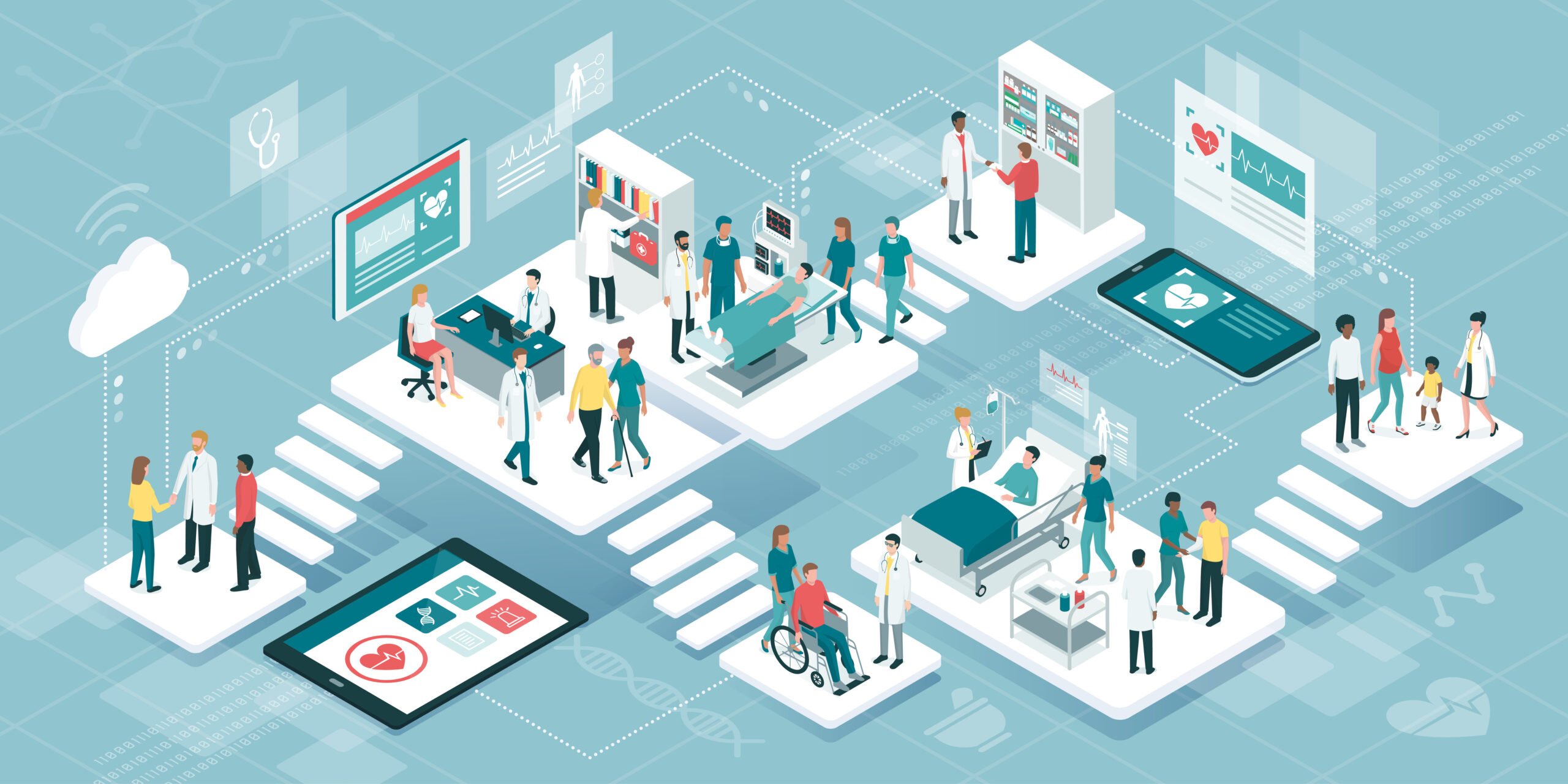Streamlining patient flow is pivotal for increasing patient satisfaction and improving the overall efficiency of healthcare facilities. Hospitals can significantly enhance patient throughput by addressing the core issues that lead to bottlenecks and implementing innovative strategies. This not only ensures patient safety and high-quality patient care but also optimizes the utilization of hospital resources, saving time and costs for healthcare providers.
In the complex ecosystem of healthcare facilities, ensuring smooth patient flow presents a multitude of challenges that can directly impact patient care and satisfaction. Hospitals face the daunting task of managing admitted patients efficiently, which is crucial for preventing delays in care and enhancing patient safety.
The intricacies of patient throughput, from emergency admissions to inpatient units, demand a strategic approach to optimize processes and eliminate bottlenecks. This challenge is not only about managing the physical movement of patients within the health system but also about ensuring that the care team can deliver timely and effective treatment. Delays and inefficiencies in patient flow (otherwise known as hospital flow) can lead to overcrowded waiting rooms, extended patient wait times, and ultimately, a decline in healthcare improvement outcomes.
The Importance of Streamlining Patient Flow

Understanding what is patient flow management and integrating solutions like Real-Time Location Systems (RTLS) benefits patient flow by providing accurate, real-time data that helps in making informed decisions. Effective management of patient flow has a profound impact on the healthcare facility’s ability to deliver care promptly, increase patient satisfaction, and maintain a high standard of patient safety. In this context, exploring how technology, especially solutions offered by companies like AiRISTA, can aid in achieving these goals is essential for healthcare improvement and operational excellence.
What is Patient Flow?
Patient flow refers to the movement of patients through healthcare facilities, from entry through discharge, including all the clinical and administrative processes in between. It encompasses every step of the patient’s journey, highlighting the importance of seamless transitions between departments, efficient patient throughput, and minimizing delays in care. Effective patient flow management is pivotal for ensuring patient safety, optimizing patient care, and enhancing patient satisfaction within the health system.
Key Indicators of Efficient Patient Flow
Efficient patient flow can be measured through various key indicators, including reduced patient wait times, increased patient throughput, and high levels of patient satisfaction. Other crucial metrics involve minimizing delays in care, ensuring timely access to treatment and diagnostic services, and effective communication within the care team.
Healthcare facilities that achieve efficient patient flow are also marked by their ability to save time for both patients and healthcare providers, improve healthcare outcomes, and maintain a streamlined operation that supports the safety and well-being of admitted patients. These indicators are essential for hospital leaders and healthcare improvement specialists in evaluating the effectiveness of patient flow strategies and implementing changes to enhance the overall patient care experience.
Strategic Approaches to Enhancing Patient Flow
In the dynamic environment of healthcare, managing patient flow efficiently is crucial for delivering high-quality care and ensuring patient satisfaction. Innovative strategies, underpinned by technological advancements, have shown significant promise in streamlining operations and improving patient throughput. These approaches not only aim to enhance the patient experience but also optimize resource allocation and staff efficiency.
Leverage Technology for Efficient Scheduling
Implementing Advanced Scheduling Systems
Advanced scheduling systems utilize sophisticated algorithms to match patient appointments with available healthcare provider schedules, optimizing time and resources. This technology accounts for variables such as appointment type, provider availability, and patient preferences, ensuring a smooth scheduling process that minimizes wait times and maximizes patient throughput.
The Role of Predictive Analytics in Staffing and Resource Allocation
Predictive analytics leverages historical data and machine learning algorithms to forecast patient inflow, enabling healthcare facilities to allocate staff and resources proactively. This foresight helps in preparing for peak times, reducing bottlenecks, and ensuring that patient care is maintained due to staffing shortages or resource constraints.
Expand Telehealth Services
Reducing In-Person Visits Through Telehealth
Telehealth services have revolutionized patient care by offering remote consultations, diagnosis, and treatment options. This reduces the need for in-person visits, alleviating pressure on healthcare facilities and enabling patients to receive care from the comfort of their homes. The result is a more streamlined patient flow, reduced wait times, and increased access to healthcare services.
Streamline Admission and Discharge Processes
Simplifying Registration with Digital Solutions
Digital registration platforms streamline the admission process by allowing patients to submit their information online before their visit. This reduces paperwork, speeds up the registration process, and improves the overall efficiency of hospital admissions.
Accelerating Discharge Procedures to Free Up Beds
Efficient discharge processes are essential for optimizing bed utilization and improving patient flow. Digital tools that facilitate quicker discharge documentation, patient education, and post-discharge care coordination can significantly reduce the time patients spend waiting for discharge, thereby freeing up beds more rapidly. Location insights can play a role in efficient patient discharge. AiRISTA’s Sofia RTLS platform can alert cleaning crews when the patient has left the room and it is ready to be cleaned. Once complete, the cleaning personnel notify the Sofia system when the room is clean and is then available for the next patient.
Optimize Emergency Department (ED) Flow
Triage Innovations for Faster Patient Sorting
Innovations in triage, such as automated triage systems, help prioritize patient care based on the severity of their condition. These systems ensure that critical patients receive immediate attention, while others are efficiently directed to the appropriate care settings, improving ED flow and reducing wait times.
Coordination Between ED and Inpatient Units
Effective coordination between the ED and inpatient units is crucial for seamless patient transfers. Implementing protocols for rapid communication and bed allocation ensures that patients can be moved from the ED to inpatient care without unnecessary delays, enhancing the overall efficiency of patient flow. AiRISTA’s sofia RTLS solution can send automated messages to the display of tags worn by porters with the location and destination of a transport request. Once complete, the porter pushes a button on the tag to indicate completion.
Enhance Communication and Coordination
Implementing Integrated Communication Systems
Integrated communication systems facilitate real-time information exchange among healthcare teams, ensuring that all members are up-to-date on patient status and care plans. This enhances coordination, reduces errors, and improves the speed and quality of patient care. With 2-way communicating personnel tags like AiRISTA’s B4n tag, messages can be sent to staff to help orchestrate workflows.
Cross-Departmental Collaboration for Smooth Transitions
Fostering cross-departmental collaboration through regular meetings and shared information systems ensures smooth patient transitions between different care settings. This collaborative approach minimizes delays and promotes a more streamlined patient flow throughout the healthcare facility.
Implement Real-Time Location Systems (RTLS)
The Basics of RTLS in Healthcare
RTLS solutions provide real-time tracking of patients, staff, and equipment, offering insights into the efficient use of resources and the optimization of patient flow. By understanding movement patterns within the facility, healthcare providers can identify bottlenecks and implement strategies to improve efficiency.
Improving Patient and Asset Tracking for Efficiency
Effective tracking systems enable healthcare facilities to quickly locate equipment and move patients through various stages of care, reducing wait times and improving the overall patient experience.
Benefits of RTLS for Patient Flow Management
RTLS technology offers numerous benefits, including enhanced operational efficiency, improved patient safety, and reduced healthcare costs. By providing accurate, real-time information, RTLS helps healthcare facilities optimize workflows and improve patient care.
Challenges and Considerations in RTLS Implementation
Implementing RTLS technology requires careful planning, including considerations for integration with existing systems, staff training, and privacy concerns. Despite these challenges, the benefits of RTLS for improving patient flow and healthcare outcomes are substantial, making it a valuable investment for healthcare facilities aiming to enhance their operations.
To increase the relevance of location information with workflows, AiRISTA created a low-code integration studio called Flow Studio. Flow Studio is a graphical drag-and-drop tool for connecting code modules and applications into a visual workflow to coordinate teams.
By adopting these strategic approaches, healthcare facilities can significantly improve patient flow, ensuring patients receive timely, efficient care, and optimizing the use of resources and staff.AiRISTA’s RTLS healthcare solutions have proven their effectiveness in real-world healthcare settings. Our case studies highlight scenarios where their system facilitated swift response to emergencies, resulting in improved staff safety and patient care. These examples demonstrate how RTLS integration into staff duress systems can transform the emergency response protocol in healthcare, making it more efficient and reliable.
Overcoming Common Obstacles
Addressing Staff Resistance to New Technologies
Introducing new technologies in healthcare settings often faces resistance from staff accustomed to traditional methods. To overcome this, it’s essential to involve staff early in the decision-making process, providing comprehensive training and highlighting the benefits of new technologies, such as improved patient flow and reduced workload. Clear communication and demonstration of positive outcomes can significantly ease the transition, fostering a more receptive environment.
Managing Change in High-Stress Environments
Healthcare environments are inherently high-stress, and managing change within them requires a sensitive, structured approach. Implementing gradual changes, providing support systems for staff, and ensuring open lines of communication are critical. Acknowledging the challenges and stresses faced by healthcare professionals and offering solutions that address these concerns can facilitate smoother transitions and acceptance of new processes or technologies.
Overcoming Technical Challenges with RTLS Deployment
Deploying Real-Time Location Systems (RTLS) in healthcare facilities comes with its set of technical challenges, from integration with existing systems to ensuring accurate and reliable tracking. To overcome these obstacles, it’s crucial to work with experienced vendors who understand the unique needs of healthcare environments and have developed deep debugging and management tools. Conducting pilot tests, phased rollouts, and continuous training can help identify and address issues early, ensuring a successful implementation. Additionally, regular feedback sessions with end-users can provide insights into further refinements, ensuring the technology meets the facility’s needs and enhances patient flow effectively.
Measuring Success and Making Adjustments
Key Performance Indicators (KPIs) for Patient Flow
To gauge the effectiveness of strategies implemented to enhance patient flow, healthcare facilities must rely on specific Key Performance Indicators (KPIs). These include metrics such as reduced wait times, increased patient throughput, improved patient satisfaction scores, and decreased length of hospital stay. Monitoring these KPIs provides valuable insights into the efficiency of patient flow management and highlights areas for improvement.
Evaluating the Impact of RTLS on Hospital Operations
The implementation of Real-Time Location Systems (RTLS) can significantly influence hospital operations by improving asset tracking, staff coordination, and patient care delivery. Assessing the impact of RTLS involves measuring changes in equipment utilization rates, response times to patient needs, and overall operational efficiency. These evaluations help in understanding the value added by RTLS technologies and in making informed decisions for future investments.
Continuous Improvement: Learning from Data and Feedback
The journey towards optimizing patient flow is ongoing, necessitating a culture of continuous improvement. By analyzing data collected from various sources, including RTLS, and soliciting feedback from both staff and patients, healthcare facilities can identify trends, uncover inefficiencies, and discover opportunities for enhancement. This iterative process ensures that patient flow management strategies remain effective and responsive to the evolving needs of the healthcare environment.
The Future of Patient Flow in Hospitals
The future of patient flow in hospitals looks promising, with advancements in technology and process optimization leading the way. As healthcare facilities continue to embrace innovative solutions like Real-Time Location Systems (RTLS) and telehealth services, the efficiency of patient flow is set to improve significantly. These technologies, combined with a strategic approach to scheduling, admissions, and staff coordination, will streamline operations and enhance patient care.
Encouraging a Culture of Continuous Improvement
To sustain progress, hospitals must foster a culture of continuous improvement, where feedback is valued, and data-driven decisions are standard practice. Encouraging this culture ensures that hospitals remain adaptable, responsive to changes, and committed to optimizing patient flow for the betterment of patient care and operational efficiency. This ongoing commitment to innovation and improvement will shape the future of healthcare, making it more efficient, effective, and patient-centered.





